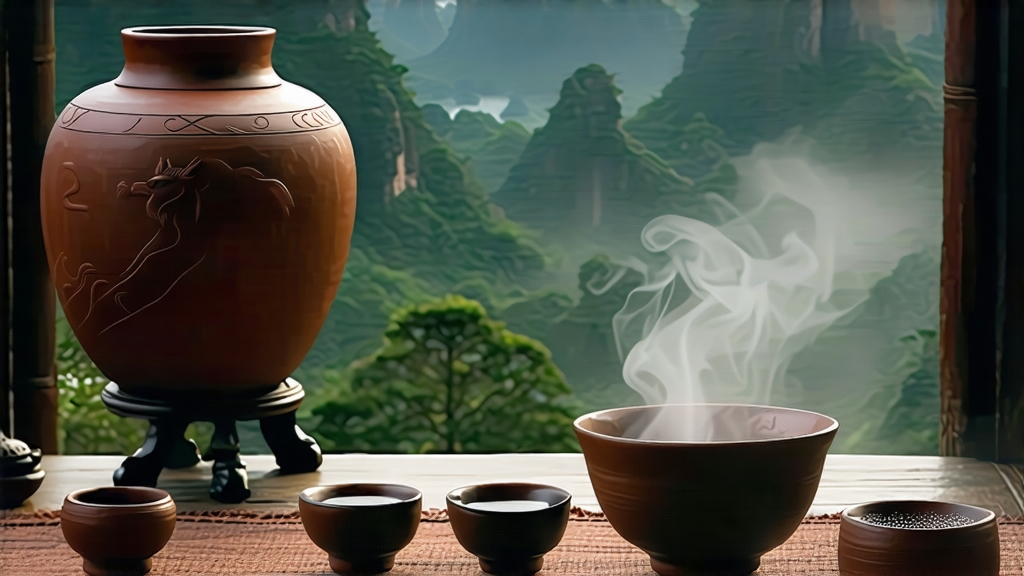
Tucked into the humid folds of southern China’s Guangxi Zhuang Autonomous Region, Liu Bao (literally “Six Forts”) is the quietest celebrity of the dark-tea family. While Pu-erh hoards headlines, Liu Bao has spent four centuries maturing in terracotta jars, bamboo baskets and the cargo holds of junks that once sailed the Pearl River to Southeast Asia. The tea takes its name from the six ancient stockades that guarded the trade route winding through the Dayao Mountains; today those same hills provide the mist, red soil and indigenous cultivars that give Liu Bao its unmistakable betel-nut bouquet and silky, medicinal depth.
History: From Border Garrison to Maritime Currency
Liu Bao’s documented story begins in the late Ming dynasty, when imperial troops stationed along the Guangxi-Guangdong border bartered compressed tea for supplies with local Yao and Zhuang minorities. By the Qing Qianlong era (1736–1795), the tea had become a tributary item and a ballast commodity on the “Tea Horse Road” sea route. Junks carried Liu Bao from Wuzhou port to Hong Kong, Malacca and Jakarta, where Chinese coolies discovered that the tea prevented dysentery in the tropics. In 1886 the British colonial government of Malaya listed Liu Bao as a “health beverage” exempt from import duty, cementing its reputation as “coolie tea” that was anything but common. Warehouses in Kuala Lumpur and Singapore deliberately aged the bricks for decades, creating the world’s first secondary market for post-fermented tea long before Pu-erh caught up in the 1990s.
Micro-Terroir: The Dayao Mountains’ Fungal Symphony
Unlike Yunnan’s broad-leaf assamica, Liu Bao is made from a medium-leaf variant of Camellia sinensis var. sinensis that thrives between 300–800 m on granite-derived lateritic soil. The region’s annual 1,600 mm rainfall and 85 % humidity nurture a native microbiota dominated by Aspergillus niger, Blastobotrys adeninivorans and a rare yeast now catalogued as Cyberlindnera liubaoensis. These organisms colonise leaf surfaces during the unique “wet-piling” phase, producing metabolites that translate into Liu Bao’s signature notes of nutmeg, camphor and dried longan.
Craft: The Eight-Step Alchemical Cycle
- Plucking: two leaves and a bud around Qingming, when spring mist lingers until noon.
- Solar Withering: 4–6 h on bamboo trays; leaf moisture drops to 60 %, initiating grassy-to-herbal aroma transition.
- Indoor Withering: piled 15 cm deep for 2 h; enzymatic oxidation edges toward 15 %, turning edges reddish.
- Kill-Green: 5 min at 180 °C in a waist-high wok; the “first crack” of Liu Bao, arresting oxidation yet preserving fungal spores.
- Rolling: 40 min on a bamboo table, twisting cells without rupturing them excessively—critical for later microbial infiltration.
- Sun-Drying: spread 2 cm thick on rattan racks; 6 h of mountain sun reduces moisture to 12 %, creating the “maocha”半成品.
- Wet-Piling (渥堆): the soul of Liu Bao. Maocha is sprayed with mountain spring water (28 % by weight), piled 70 cm high and covered with jute sacks. Internal temperature climbs to 55 °C within 36 h; every 5 days the pile is turned, aerated and re-moistened. After 25–30 days the leaf turns chestnut-brown, and a sweet, earthy aroma rises—part compost, part dried apricot.
- Compression & Curing: the fermented tea is steamed for 30 s, pressed into 500 g baskets lined with bamboo bark, then transferred to unglazed Guangxi clay jars (埕). The jars breathe, allowing micro-oxygenation while keeping relative humidity at 70 %. Traditional traders aged the tea for “three summers” before selling, but connoisseurs now seek 15-, 30- even 50-year lots.
Variations within the Forts
- Basket Liu Bao (竹篓茶): the classic, packed in 36–50 kg bamboo baskets, retains the highest moisture gradient and ages fastest.
- Brick